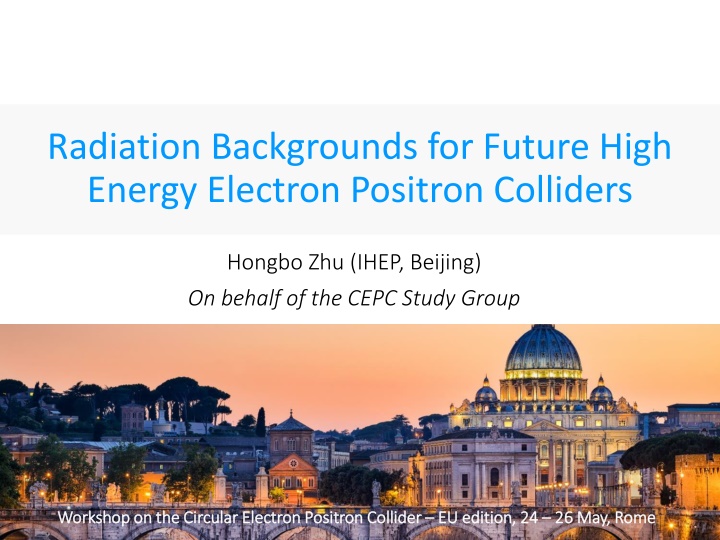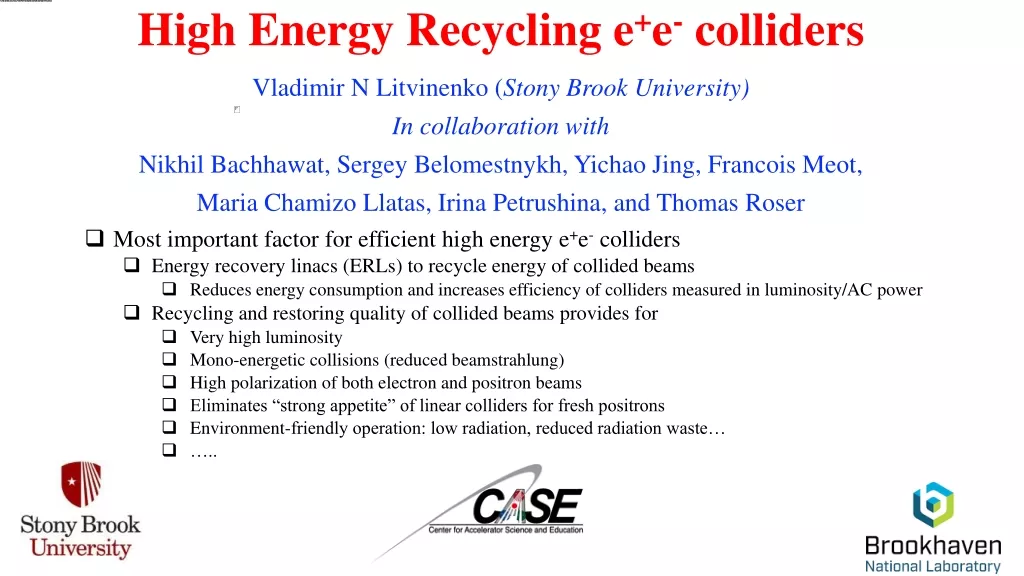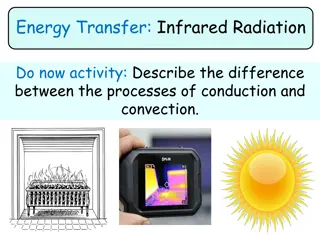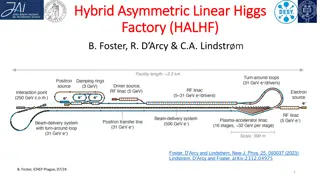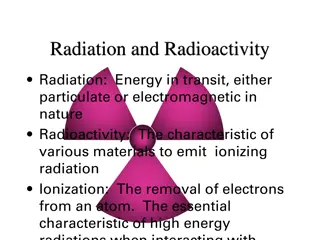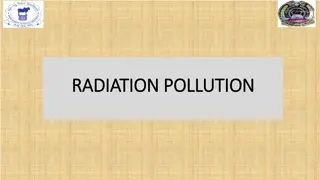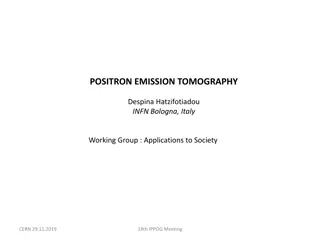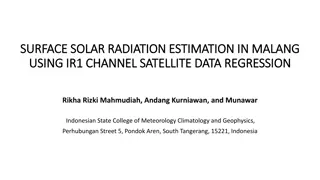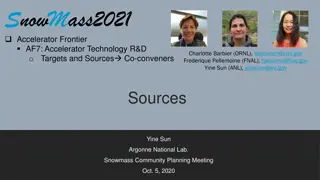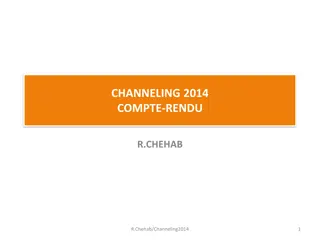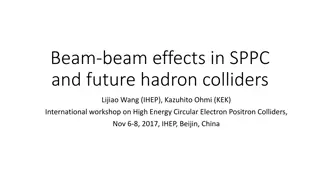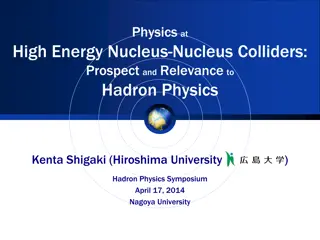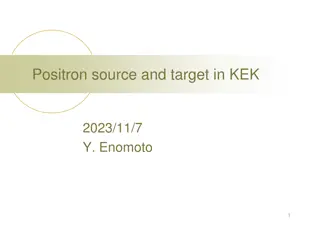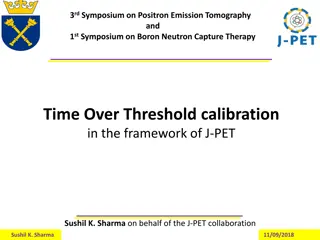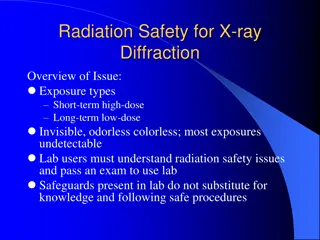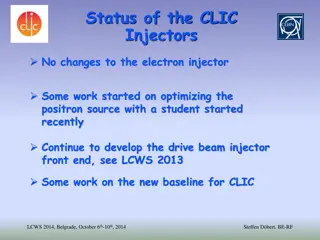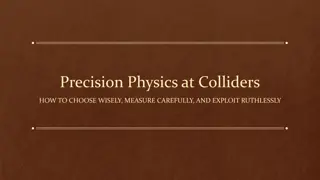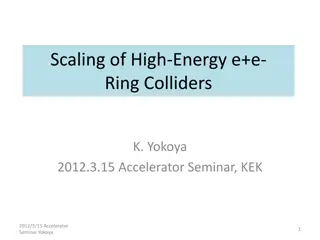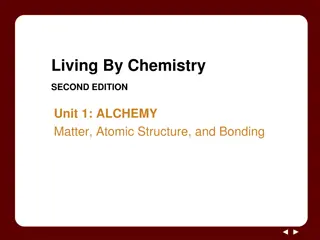Radiation Backgrounds for Future High Energy Electron Positron Colliders
This presentation by Hongbo Zhu explores radiation backgrounds and their impact on the design of high-energy electron-positron colliders. It covers crucial sources of radiation backgrounds and their implications for detector designs, focusing on pair production, beam losses, and synchrotron radiation. The layout of the interaction region and machine parameters are also discussed in detail.
Download Presentation

Please find below an Image/Link to download the presentation.
The content on the website is provided AS IS for your information and personal use only. It may not be sold, licensed, or shared on other websites without obtaining consent from the author.If you encounter any issues during the download, it is possible that the publisher has removed the file from their server.
You are allowed to download the files provided on this website for personal or commercial use, subject to the condition that they are used lawfully. All files are the property of their respective owners.
The content on the website is provided AS IS for your information and personal use only. It may not be sold, licensed, or shared on other websites without obtaining consent from the author.
E N D
Presentation Transcript
Radiation Backgrounds for Future High Energy Electron Positron Colliders Hongbo Zhu (IHEP, Beijing) On behalf of the CEPC Study Group Workshop on the Circular Electron Positron Collider Workshop on the Circular Electron Positron Collider EU edition, 24 EU edition, 24 26 May, Rome 26 May, Rome
Outline Interaction Region Layout Radiation Backgrounds Summary Radiation Backgrounds, H. Zhu 2 24-26 May 2018
Interaction Region ILD Preliminary layout of the interaction region Preliminary layout of the interaction region: extremely limited space for several critical components trade-offs Optimizations required in the forward region and installation scheme to be developed toward a more realistic design Radiation Backgrounds, H. Zhu 3 24-26 May 2018
Radiation Backgrounds Important inputs in to detector (+machine) designs, e.g. detector occupancy, radiation tolerance Have investigated the most important sources of radiation backgrounds, including Pair production Beam lost/off-energy particles Synchrotron radiation Extending into other less critical sources Radiation Backgrounds, H. Zhu 4 24-26 May 2018
Machine Parameters Z 3T Z 2T Higgs W Number of IPs 2 Beam energy (GeV) 120 80 45.5 Circumference (km) 100 Synchrotron radiation loss/turn (GeV) 1.73 0.34 0.036 16.5 2 Crossing angle at IP (mrad) Piwinski angle Number of particles/bunch Ne (1010) Bunch number 2.58 7.0 23.8 15.0 12.0 8.0 242 1524 12000 (10% gap) Bunch spacing (ns) 680 210 25 Beam current (mA) 17.4 87.9 461.0 Synchrotron radiation power (MW) 30 30 16.5 Bending radius (km) 10.7 Momentum compaction (10-5) function at IP x* / y* (m) Emittance x/y (nm) Beam size at IP sx /sy ( m) Beam-beam parameters x / y RF voltage VRF (GV) RF frequency fRF (MHz) 1.11 0.36/0.0015 0.36/0.0015 0.2/0.0015 0.2/0.001 1.21/0.0031 0.54/0.0016 0.18/0.004 0.18/0.0016 20.9/0.068 13.9/0.049 6.0/0.078 6.0/0.04 0.031/0.109 0.013/0.106 0.004/0.056 0.004/0.072 2.17 0.47 0.10 650 Harmonic number 216816 Natural bunch length sz (mm) Bunch length sz (mm) Damping time tx/ty/tE (ms) Natural Chromaticity Betatron tune x/ y/ s HOM power/cavity(2cell) (kw) 2.72 2.98 2.42 3.26 5.9 8.5 46.5/46.5/23.5 156.4/156.4/74.5 849.5/849.5/425.0 -520/-3067 -493/-1544 -493/-1544 -520/-1544 363.10 / 365.22 / 0.065 0.54 0.75 1.94 Natural energy spread (%) Energy acceptance requirement (%) 0.1 1.35 0.066 0.40 0.038 0.23 Energy acceptance by RF (%) 2.06 1.47 1.70 Photon number due to beamstrahlung Lifetime _simulation (min) 0.29 100 0.35 0.55 2.1 Lifetime (hour) 0.67 1.4 4.0 F (hour glass) Luminosity/IP L (1034cm-2s-1) 0.89 0.94 0.99 2.93 10.1 16.6 32.1 Radiation Backgrounds, H. Zhu 5 24-26 May 2018
Pair Production Estimated as the most important background at Linear Colliders, not an issue for lower energy/luminosity machines Charged particles attracted by the opposite beam emit photons (beamstrahlung beamstrahlung), followed by electron-positron pair production (dominate contributions from the incoherent pair production) Most electrons/positrons are produced with low energies and in the very forward region, and can be confined within the beam pipe with a strong detector solenoid; However, a non-negligible amount of particles can hit the detector radiation backgrounds radiation backgrounds Hadronic backgrounds much less critical Radiation Backgrounds, H. Zhu 6 24-26 May 2018
Event Generation Pair production process simulated with the GuineaPig program and the output fed into Geant4 detector simulation Long time for colliding bunches to cross each other (e.g. Higgs operation with bunch length ~3.6 mm) CEPC CEPC Caveat: charged particles travelling over certain distance without seeing the solenoidal field, which unfortunately introduces bias to the hit positions To implement external field in the GuineaPig, feature request sent to the author (to be followed up) ILC ILC Radiation Backgrounds, H. Zhu 7 24-26 May 2018
Pair Production @ W/Z More prominent at W/Z because of event longer bunch sizes and charged particles traveling over even longer distances Radiation Backgrounds, H. Zhu 8 24-26 May 2018
Radiation Background Levels S. Bai, W. Xu and X. Wang Using hit density, total ionizing dose (TID) and non-ionizing energy loss (NIEL) to quantify the radiation background levels Adopted the calculation method used for the ATLAS background estimation (ATL-GEN-2005-001), safety factor of 10 applied Radiation Backgrounds, H. Zhu 9 24-26 May 2018
Higgs, W and Z NIEL per year Hit density, TID and NIEL at the 1st VXD layer (r = 1.6 cm) for operation at different energies Bunch spacing: 680 (H)/210 (W)/25 (Z) ns Hit density (per bunch crossing) TID per year Radiation Backgrounds, H. Zhu 10 24-26 May 2018
Beam Lost Particles Beam particles losing energies (radiative Bhabha scattering, beam-gas interaction, beam-gas interaction, etc.) larger than acceptance kicked off their orbit lost in the interaction region Two sets of collimators placed upstream to stop off-energy beam particles, sufficiently away from the beam clearance area (aperture size subject to optimization) What shape? What shape? SuperKEKB Type (PEP-II as reference) Radiation Backgrounds, H. Zhu 11 24-26 May 2018
Effectiveness of Collimators Suppression of detector backgrounds, close to a factor of 100 in reduction remaining backgrounds smaller than that from pair production and there is room for further tuning Radiation Backgrounds, H. Zhu 12 24-26 May 2018
Combined Backgrounds 2 1012 1MeV neq/cm2 per year Radiation backgrounds from pair production, radiative Bhabha scattering + beamstrahlung Most significant contributions from the pair production 2.5 hits/cm2 per bunch crossing 1 MRad per year Radiation Backgrounds, H. Zhu 13 24-26 May 2018
Synchrotron Radiation K. Li & M. Sullivan (SLAC) Beam particles bent by magnets (last bending dipole, focusing quadrupoles) emit SR photons important at circular machines BDSim to transport beam (core + halo) from the last dipole to the interaction region and record the particles hitting the central beryllium beam pipe Large amount of photons scattered by the beam pipe surface between [1, 2 m] into the central region Collimators made with high-Z material must be introduced to block those SR photons. Radiation Backgrounds, H. Zhu 14 24-26 May 2018
Mask Tips Radiation Backgrounds, H. Zhu 15 24-26 May 2018
With Collimation Three masks at 1.51, 1.93 and 4.2 m along the beam pipe to the IP to block SR photons shielding to the central beam pipe Number of photons per bunch hitting the central beam pipe dropping from 40, 000 to 80; power deposition reduced considerably Radiation Backgrounds, H. Zhu 16 24-26 May 2018
Summary Preliminary interaction region design that requires further optimization Investigated the main radiation backgrounds that are important for detector design (pair production to be re-visited shortly); more sources of backgrounds to be included Hit density: 2.5 hits/cm2 per bunch crossing TID: 1 MRad per year NIEL: 2 1012 1MeV neq/cm2 per year Radiation Backgrounds, H. Zhu 17 24-26 May 2018
